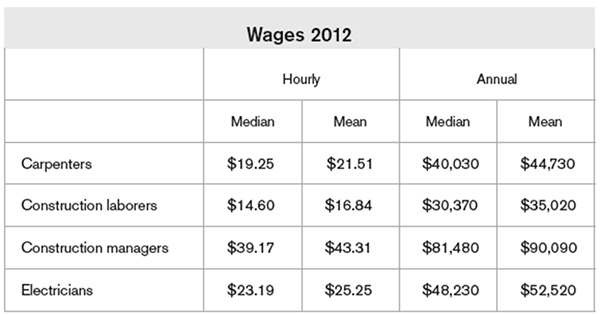
The construction industry can’t seem to catch a break. After weathering one of the greatest financial meltdowns the industry has seen, contractors face another storm looming on the horizon. Some experts say the U.S economy is far from stable and hovers on the precipice of failure with each new world event that occurs. Others remain optimistic as housing starts increase and the Dow surges to new heights. Each month, political pundits anxiously await new jobs reports. According to the Bureau of Labor Statistics, construction unemployment has dropped from 15.7 percent in February to 9 percent in October. Depending on the perspective, these statistics are either a good sign—a six- to seven-point decrease in four months—or a bad sign—almost three points higher than the total unemployment rate of 7.6 percent for all industries. Even with a rate of 9 percent, the construction industry has an employment crisis on its hands and will continue to wrestle with it for many years if leaders do not “stand to right the ship.”
Even in a stagnant or mildly growing economy, most firms contend they cannot find good people. Union or merit shop, it does not matter. Construction organizations today are failing to find qualified craft labor and technicians. Universities and colleges continue to produce strong management candidates, but identifying and recruiting front-line tradespeople is one of the greatest challenges facing the construction industry today. Without carpenters, electricians and finishers, project management will become a great deal more complicated.

Triaging the Problem
An interesting dichotomy is occurring in the world today. On one hand, countless young men and women argue that they are unemployed, byproducts of a failed economy. On the other hand, many construction firms are starving for young talent. Is this just a case of the employers and pool of potential employees failing to meet? Or is the issue deeper and dirtier? Ask 18- or 19-year-olds today their opinion of a construction job, and the answer might explain many of the industry’s employment issues. Most surveys show that construction is one of the lowest-rated jobs in the marketplace. Better stated, it is a “dirty job.” The pinnacle of success today seems to be going to college and attaining a degree, regardless of the specialization and the mounds of student debt that results. However, many people who go to college would be better-suited for a career in the trades. While no one wants to think of his or her son or daughter as a poor student, more often than not, children who fail to achieve higher grades and test scores are often relegated to vocational programs that don’t have the notoriety and acclaim of other institutions. In some instances, students are pushed toward college even when their skills scream otherwise. Construction work has been relegated to those who simply can’t make it in school and provides a “last resort” rather than a first option.
Mike Rowe, famed actor, narrator and producer on the Discovery Channel, appeared weekly on a show titled “Dirty Jobs.” When he wasn’t picking up animal carcasses, Rowe was often up to his elbows—or shins—in concrete or demolition debris, highlighting some of the most challenging jobs in the construction industry. Rowe’s legacy has been forever cemented in the industry annals not by his show but by his work with legislators. Rowe has taken to advocating for these so-called “dirty jobs” and pleading with government officials to refocus their efforts on showcasing the importance of being a tradesperson. States such as Alabama and Georgia are working in cooperation with Rowe, but time will tell how successful this grassroots campaign will be.
Consider the data in Table 1. While this information represents a broad cross section for the industry, it provides some semblance of quantification.
 Table 1. Wage Rates for a Sample Set of Trade Roles in the Construction Industry. Source: Bureau of Labor Statistics
Table 1. Wage Rates for a Sample Set of Trade Roles in the Construction Industry. Source: Bureau of Labor StatisticsThe rate shown for a construction laborer alone is attention-getting. While the rate does not include other benefits, it demonstrates evidence contrary to one of the misguided perceptions that construction jobs are low-paying. So, is the labor crisis based on mistruths in the industry or lingering stigmas of being dirty? Everyone in the industry would agree that construction is arduous and at times dangerous; however, few can challenge the rewarding nature of building some of the nation’s greatest buildings and infrastructure. Regardless of the rewarding nature of the job, being a construction worker is perceived as a last-ditch career with little upside.
Acting Locally
A small to midsize contractor may view this problem with a sense of futility. What can you do to change the perceptions of not only younger generations but also parents, teachers, guidance counselors and principals? A middle school-aged child or even a high school-aged young woman or man does not form a negative perception of the construction industry without the assistance of an adult role model. Consider this: A child comes home from school in 1950 and tells his parents he has elected to join the electrical union. At the time, the occupation is viewed with pride, and the parents encourage the child. Fast-forward to 2013: That same child would be vilified for having aspirations to become a carpenter, pipefitter or operator. At this point, does the child have a skewed opinion of construction or does the parent have the skewed opinion?
While construction might not become the most sought-after career, firms must avoid “acting the role” of industry victim and playing the part. For instance, contractors must avoid the perpetuation of the “dirty contractor.” In response, many firms have focused on creating a positive self-image by demanding higher standards in all aspects of the job, including something as simple as attire. Whether a firm has uniforms or a dress code, leadership should require attire that says, “We will show respect for our work, ourselves and our customers.” While the expectations shouldn’t be Italian loafers and dress slacks, wearing a cut-off T-shirt with hole-ridden jeans should be unacceptable. Self-image isn’t limited to apparel. Whether an unkempt fleet of vehicles or the run-down office building, contractors must understand how each of these factors reinforces an already tarnished reputation. The expectation is not to have the most expensive vehicles or an office complete with teak and mahogany but rather to display a professional and welcoming appearance.
The second critical industry makeover tactic is outreach. Parents are not the only ones who have a distinct opinion about construction. Educators and administrators must be educated about the benefits of a career in construction. When college is viewed as the pinnacle of personal success, people tend to diminish the other 60 to 70 percent who will never go to college. Begin this education process early at all levels—kindergarten through high school. For example, many contractors are spending time at the grade school level sharing their building successes, demonstrating their equipment and illustrating the career path of a construction professional. The delivery of the message will be different for a third-grader than it will be for a senior in high school, but the context of creating passion for our industry must be indelible and deliberate.
Lastly, firms and trades across the industry must have a united focus to recognize the issue and proactively solve the problem. However, consider the message the world hears when the industry says, “We need to focus on construction jobs as long as they are union….” or “…as long as they are highway projects or ‘green’ projects, etc.” Specialization of trade groups has benefitted the construction industry; however, the fragmentation of the industry to the “non-practicing” world has created a convoluted message. The industry needs a greater unifying force among not just trade groups but also firms of all makes and models to educate their communities about the benefits of a career in construction. Additionally, construction professionals must continually reinforce the message, so the industry can gain traction and momentum. The construction industry must serve as a bastion and resource for building both great structures and great people.

Uniting Globally
Time is working against the construction industry. As baby boomers exit the industry, neither the numbers nor the desire is available to replace a declining workforce. Even with the symptoms identified, the sickness affecting the industry will require time to reshape the image and abolish stigmas. In fact, the same economic forces that plundered the industry may, in fact, help to rebuild it. Consider the new infatuation with the energy sector. Dreams of economic prosperity have grown as labor has relocated to areas of North America like North Dakota, Ohio, Pennsylvania and Alberta, Canada. The labor crisis could “self-regulate” as more building takes place. However, reactive passivity may also lead to greater risk and tumultuousness for construction. By adopting a “wait-and-see” perspective, firms may end up placing their success or failure in the hands of untrained, unqualified personnel.
Some also lament that this newer generation “lacks the motivation” to be successful. Put another way, they just don’t work the same way people of yesteryear do. While today’s generation might be different than those of the past in some ways, the newer generation may have exactly what firms need to grow. For instance, technology, teamwork and collaboration are just a few areas in which newer generations excel.
Changing the image of the construction industry will not be easy. Change might not occur at the pace needed to drive manageable growth for the country’s leading firms. However, true industry leaders are focusing their strategic plan at a macro level to include the critical element of talent development both internally and externally. Firms may deal with dirt, but hopefully, that will no longer be the detriment but instead will become the most enjoyable aspect of the work.
